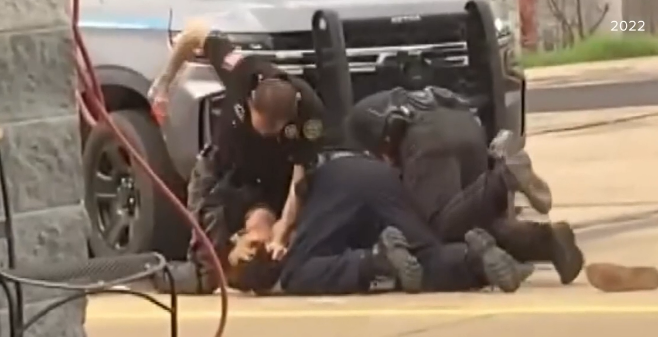Each year 70 percent, or more, of prisoners are attacked by other inmates. According to Human Rights Watch, an estimated 140,000 prisoners are raped annually.
[Speaking Truth To Power]
In America’s largest ever non-violent prisoner strike, thousands of inmates—of all colors—across Georgia have refused to participate in work details or do chores since December 9.
Georgia’s inmate strike was organized with the help of the “Concerned Coalition to Respect Prisoners’ Rights,” spearheaded by women from Georgia. The group is currently working with Georgia’s NAACP and both, collectively, are calling for a federal investigation into Georgia’s prison conditions, which prisoners oppose. Inmates, from, possibly, as many as 11 prisons, have taken part in the strike.
The Department of Corrections (DOC), has evaded comment on the situation, but apparently, they’re too busy brutalizing prisoners involved in the strike. A letter to Georgia Governor Sonny Perdue, from Georgia NAACP Chair Edward Dubose
reads in part: “I implore you to direct the Department of Corrections, headed by Commissioner Brian Owens, to cease and desist from using violent tactics to force prisoners engaged in a non-violent labor strike to return to work.”
Prisoners have reported being beaten by guards; having personal property destroyed; as well as seeing the heat and hot water turned off on them with the temperature around 30 degrees. But, the prisoners have continued to strike.
“These men are pretty much committed,” said former Black Panther, Elaine Brown, a spokeswoman for the organizing group. “They are behind walls, their lives are totally controlled and they are being asked to work for free–and are treated
like animals. I don’t see how this is not an obvious human rights issue.”
Reportedly, inmates used illegal cell phones smuggled into the prisons to organize the action. Brown said, as of Monday, she was still in contact with prisoners by the use of the cell phones.
Since last Thursday, prisoners from Smith State Prison, Hays State Prison, Macon State Prison, Baldwin State Prison, Telfair State Prison and Hancock State Prison have been striking to force the Georgia Department of Corrections to
institute better living and work conditions.
Among inmates demands are: (1) Prisoners want to be paid, since, Georgia’s prisoners work for free, unlike other states. (2) Educational and skills training opportunities, Georgia’s DOC, reportedly, deny educational programs—above a GED—for most prisoners. (3) Decent healthcare and nutrition, which inmates say they don’t receive, and, sometimes
have to pay for. (4) Better living conditions–to address overcrowding, which creates more problems. (5) An end to cruel punishment by corrections officials; inmates argue their 8 Amendment Right is routinely violated for minor infractions. (6)Better access to their families; inmates complain of many barriers to visitation and excessive phone fees. (7) Prisoners also request just parole for eligible inmates.
The non-violent strike being taking by prisoners for better living conditions is a prelude to a coming disaster. Conditions in Georgia’s prisons mirror the nation’s. America’s prisons a festering breeding ground for future social ills. These prisoners have been admirable in their non-violent stance, but what about the impending explosions in the other bulgingly overcrowded prisons?
For far too long, the attitude of many Americans has been prisoners have no rights, because of the crimes they committed. The “law and order” crowd argues that “we can’t coddle criminals.” So why should we invest in educational programs, and the like for these riff raff? Those who advocate these positions believe people locked-up have no redeeming qualities. Most convicts are actually non-violent offenders—like those, needlessly incarcerated for drug “crimes.”
This mean-spirited and short-sighted thinking exacerbates the recidivism problem, where we see high percentages of repeat offenders. America’s recidivism rate, for prisoners within their first year of release, is 44 percent; it’s 67 percent within three years of release. Often, many inmates leave prison worse than when they went in, especially, given the high rate of physical abuse that is condoned in America’s prisons. Each year 70 percent, or more, of prisoners are attacked by other inmates. According to Human Rights Watch, an estimated 140,000 prisoners are raped annually.
If we do nothing to rehabilitate and educate prisoners how do we expect them to reintegrate into American society successfully? Why does America imprison so many? The U.S. incarcerates nearly one quarter of the world’s prisoners –around two million people– although this country has less than five percent of the world’s population.
Of those two million, nearly half are African-Americans. Yet African-Americans represent only around 12 percent of the American population. Some historians argue the over-representation of African-Americans, in American prisons, can be traced to those who wanted to continue some form of slave labor, after the abolition of slavery.
Chain gangs flourished after slavery, until they were, mostly, phase-out around the 1950’s. Incidentally, Georgia was one of the last states to stop that practice. But the economic exploitation represented by the chain gang concept is now prevalent within work-factory prisons. Here, prisoners work for pay far below the minimum wage for corporate bosses who’ve formed business alliances with prisons.
This Georgia strike should be a wake-up call that we need to address the combustible situation in our prisons. We ignore it at our own peril.
“Speaking Truth To Empower.”











